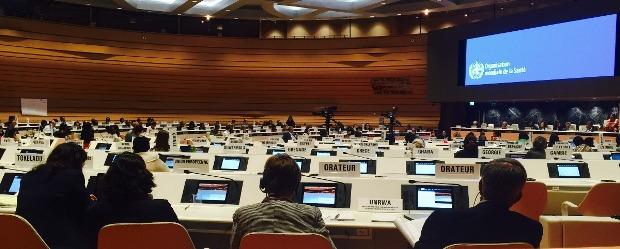Where We Work
See our interactive map


The placards went from horizontal to vertical—indicating their nation wished to speak. One after another—from Guinea to Switzerland, Thailand to the United States—they spoke with impassioned tones about the centrality of strategically addressing the health workforce gaps exasperatingly standing in the way of the enormous progress we know can be achieved in global health in the next 15 years.
And then, after civil society chimed in with similar calls of praise and pleas for vigilance, the chair called for objections. There were none, and the first ever Global Strategy on Human Resources for Health: Workforce 2030 went from draft to reality.
Working in global health advocacy, you rarely see such a vivid display of the collective work that leaders of the Frontline Health Workers Coalition (FHWC) witnessed in Geneva this past May when the world’s health ministers unanimously approved Workforce 2030 at the World Health Assembly.
A strategy is just a piece of paper if not backed by a fervent effort to ensure the right investments and policies are in place.
Flashback two-and-a-half years across the Atlantic Ocean in Recife, Brazil. Fifty-seven member states had just made five-year commitments of variable muster in addressing their country’s health workforce challenges—nearly all of the commitments coming from low- and middle-income countries. Over a dinner with health workforce policy leaders from around the world that FHWC, USAID, and others helped organize, a conversation began about the acute need for a global consensus on a strategic direction to address the most severe human resource-related barriers to ensuring everyone worldwide has access to essential health services.
The Global Health Workforce Alliance carried forward a two-year, multipronged consultation process with stakeholders from all sectors in all regions that delivered a framework for the World Health Organization to work with member states to draft Workforce 2030, which was strongly championed by USAID and across the US government.
So what does the strategy say? In brief, it sets out a vision of “accelerating progress towards universal health coverage and the UN Sustainable Development Goals by ensuring equitable access to health workers within strengthened health systems” and a series of milestones by 2020 and 2030 to achieve this vision.
And why is this important for global health progress? Consider this:
We are encouraged that the strategy provides a common framework for all countries and stakeholders to ensure a robust and resilient global health workforce; however, a strategy is just a piece of paper if not backed by a fervent effort to ensure the right investments and policies are in place.
On that front, we are hopeful that the report due this month by the United Nations High-Level Commission on Health Employment and Economic Growth, and commissioned by UN Secretary-General Ban Ki-moon in March, will have bold recommendations on how countries, donors, and civil society can work together for a fit-for-purpose health workforce we need to achieve the SDGs.
We at the Frontline Health Workers Coalition celebrate the passage of Workforce 2030, but the global health community must be vigilant to ensure its promise becomes reality.
This post originally appeared on The Collective Voice, the blog of the Global Health Council. Photo of member states debating the adoption of the Workforce 2030 strategy at the World Health Assembly in May 2016. Courtesy of Vince Blaser for the Frontline Health Workers Coalition.
Get the latest updates from the blog and eNews




